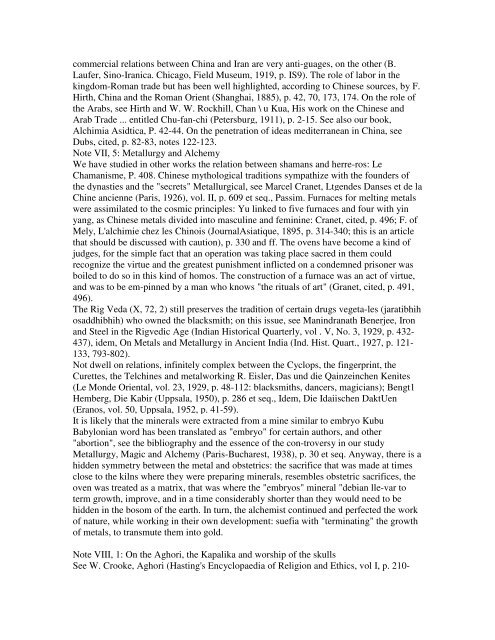Mircea Eliade YOGA IMMORTALITY AND ... - Brihaspati.net
Mircea Eliade YOGA IMMORTALITY AND ... - Brihaspati.net
Mircea Eliade YOGA IMMORTALITY AND ... - Brihaspati.net
You also want an ePaper? Increase the reach of your titles
YUMPU automatically turns print PDFs into web optimized ePapers that Google loves.
commercial relations between China and Iran are very anti-guages, on the other (B.<br />
Laufer, Sino-Iranica. Chicago, Field Museum, 1919, p. IS9). The role of labor in the<br />
kingdom-Roman trade but has been well highlighted, according to Chinese sources, by F.<br />
Hirth, China and the Roman Orient (Shanghai, 1885), p. 42, 70, 173, 174. On the role of<br />
the Arabs, see Hirth and W. W. Rockhill, Chan \ u Kua, His work on the Chinese and<br />
Arab Trade ... entitled Chu-fan-chi (Petersburg, 1911), p. 2-15. See also our book,<br />
Alchimia Asidtica, P. 42-44. On the pe<strong>net</strong>ration of ideas mediterranean in China, see<br />
Dubs, cited, p. 82-83, notes 122-123.<br />
Note VII, 5: Metallurgy and Alchemy<br />
We have studied in other works the relation between shamans and herre-ros: Le<br />
Chamanisme, P. 408. Chinese mythological traditions sympathize with the founders of<br />
the dynasties and the "secrets" Metallurgical, see Marcel Cra<strong>net</strong>, Ltgendes Danses et de la<br />
Chine ancienne (Paris, 1926), vol. II, p. 609 et seq., Passim. Furnaces for melting metals<br />
were assimilated to the cosmic principles: Yu linked to five furnaces and four with yin<br />
yang, as Chinese metals divided into masculine and feminine: Cra<strong>net</strong>, cited, p. 496; F. of<br />
Mely, L'alchimie chez les Chinois (JournalAsiatique, 1895, p. 314-340; this is an article<br />
that should be discussed with caution), p. 330 and ff. The ovens have become a kind of<br />
judges, for the simple fact that an operation was taking place sacred in them could<br />
recognize the virtue and the greatest punishment inflicted on a condemned prisoner was<br />
boiled to do so in this kind of homos. The construction of a furnace was an act of virtue,<br />
and was to be em-pinned by a man who knows "the rituals of art" (Gra<strong>net</strong>, cited, p. 491,<br />
496).<br />
The Rig Veda (X, 72, 2) still preserves the tradition of certain drugs vegeta-les (jaratibhih<br />
osaddhibhih) who owned the blacksmith; on this issue, see Manindranath Benerjee, Iron<br />
and Steel in the Rigvedic Age (Indian Historical Quarterly, vol . V, No. 3, 1929, p. 432-<br />
437), idem, On Metals and Metallurgy in Ancient India (Ind. Hist. Quart., 1927, p. 121-<br />
133, 793-802).<br />
Not dwell on relations, infinitely complex between the Cyclops, the fingerprint, the<br />
Curettes, the Telchines and metalworking R. Eisler, Das und die Qainzeinchen Kenites<br />
(Le Monde Oriental, vol. 23, 1929, p. 48-112: blacksmiths, dancers, magicians); Bengt1<br />
Hemberg, Die Kabir (Uppsala, 1950), p. 286 et seq., Idem, Die Idaiischen DaktUen<br />
(Eranos, vol. 50, Uppsala, 1952, p. 41-59).<br />
It is likely that the minerals were extracted from a mine similar to embryo Kubu<br />
Babylonian word has been translated as "embryo" for certain authors, and other<br />
"abortion", see the bibliography and the essence of the con-troversy in our study<br />
Metallurgy, Magic and Alchemy (Paris-Bucharest, 1938), p. 30 et seq. Anyway, there is a<br />
hidden symmetry between the metal and obstetrics: the sacrifice that was made at times<br />
close to the kilns where they were preparing minerals, resembles obstetric sacrifices, the<br />
oven was treated as a matrix, that was where the "embryos" mineral "debian lle-var to<br />
term growth, improve, and in a time considerably shorter than they would need to be<br />
hidden in the bosom of the earth. In turn, the alchemist continued and perfected the work<br />
of nature, while working in their own development: suefia with "terminating" the growth<br />
of metals, to transmute them into gold.<br />
Note VIII, 1: On the Aghori, the Kapalika and worship of the skulls<br />
See W. Crooke, Aghori (Hasting's Encyclopaedia of Religion and Ethics, vol I, p. 210-







